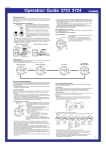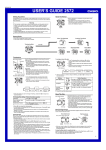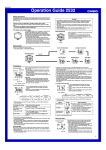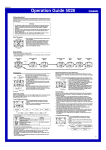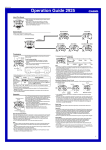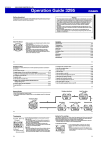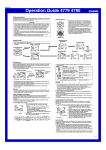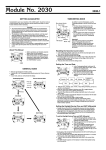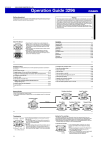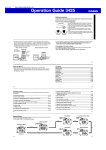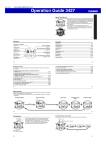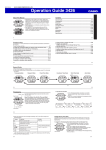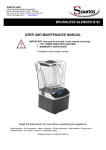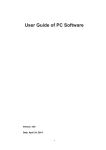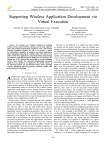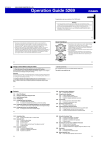Download Operation Guide 2926
Transcript
MO0503-EB Operation Guide 2926 Getting Acquainted About This Manual • Button operations are indicated using the letters shown in the illustration. • Each section of this manual provides you with the information you need to perform operations in each mode. Further details and technical information can be found in the “Reference” section. Congratulations upon your selection of this CASIO watch. To get the most out of your purchase, be sure to read this manual carefully and keep it on hand for later reference when necessary. Warning! • The longitude, lunitidal interval, Moon phase indicator, tide graph data, and solar azimuth data that appear on the display of this watch are not intended for navigation purposes. Always use proper instruments and resources to obtain data for navigation purposes. • This watch is not an instrument for calculating low tide and high tide times. The tide graph of this watch is intended to provide a reasonable approximation of tidal movements only. • When engaging in mountain climbing or other activities in which losing your way can create a dangerous or life-threatening situation, always be sure to use a second compass to confirm direction readings. • CASIO COMPUTER CO., LTD. assumes no responsibility for any loss, or any claims by third parties that may arise through the use of this watch. (Light) General Guide • The illustration below shows which buttons you need to press to navigate between modes. • In any mode, press L to illuminate the display. Moon / Tide Data Mode Countdown Timer Mode ▲ ▲ Timekeeping Mode Press C. ▲ Bearing Mode ▲ Press B. Dual Time Mode Stopwatch Mode Alarm Mode ▲ ▲ ▲ ▲ Press C. Timekeeping 1. In the Timekeeping Mode, hold down A until the seconds start to flash, which indicates the setting screen. 2. Press C to move the flashing in the sequence shown below to select other settings. |||| Year Seconds Day Hour Month Year Minutes 12/24-Hour Format 3. When the setting you want to change is flashing, use D and B to change it as described below. To change this setting Perform this button operation Seconds Press D to reset to 00. Hour, Minutes, Year, Month, Day Use D (+) and B (–) to change the setting. 12/24-Hour Format Press D to toggle between 12-hour (12H) and 24-hour (24H) timekeeping. 4. Press A twice to exit the setting screen. • The first press of A displays the GMT differential setting screen. Pressing A again exits the setting screen. • The 12-hour/24-hour timekeeping format you select in the Timekeeping Mode is applied in all modes. • The day of the week is displayed automatically in accordance with the date (year, month, and day) settings. Home Site Data ||| GMT Differential Longitude Lunitidal Interval Hours Lunitidal Interval Minutes 4. When the setting you want to change is flashing, use D and B to change it as described below. Setting Screen Button Operations GMT Differential Use D (+) and B (–) to change the setting. • You can specify a value in the range of –11.0 to +14.0, in 0.5-hour units. Longitude Use D (+) and B (–) to change the setting. • You can specify a value in the range of 179°W to 180°E, in 1-degree units. Lunitidal Interval Hours, Minutes Use D (+) and B (–) to change the setting. 5. Press A to exit the setting screen. Bearing Mode Solar azimuth The Bearing Mode lets you determine approximate directions using a displayed angle value that indicates the angle to the sun (solar azimuth). • All of the operations in this section are performed in the Bearing Mode, which you can enter from the Timekeeping Mode by pressing B. Important! Before the watch can calculate the solar azimuth (the angle of the sun in relation to your location) correctly, you must first set the correct current time, current date, and Home Site in the Timekeeping Mode. You must also specify whether the sun traverses the sky to the north or to the south of your current position. • Note that you cannot use the Bearing Mode to determine directions in the following cases. When the sun is not visible At night When sun traverses the sky directly overhead or when you cannot determine if it traverses to the north or south To set the traverse direction of the sun 1. In the Bearing Mode, hold down A until N or S flashes on the display. This indicates the setting screen. 2. Press D to toggle the setting between N (north) and S ||| (south). 3. Press A to exit the setting screen. • At this time the watch uses the traverse direction setting you just configured and the Timekeeping Mode data to calculate and display the solar azimuth. ||| Tide graph data and Bearing Mode solar azimuth data will not be displayed properly unless Home Site data (GMT differential, longitude, and lunitidal interval) is configured correctly. • The GMT differential is the time difference of the time zone where the site is located from Greenwich Mean Time. • Note that you must add one hour to the GMT differential for your time zone whenever you change to Daylight Saving Time. Subtract one hour when you change back to Standard Time. • The lunitidal interval is the time elapsing between the Moon’s transit over a meridian and the next high tide at that meridian. See “Lunitidal Interval” for more information. • This watch displays lunitidal intervals in terms of hours and minutes. • The “Site/Lunitidal Interval Data List” provides GMT differential, longitude, and lunitidal interval information around the world. • The following is the initial factory default Home Site data (Tokyo, Japan) when you first purchase the watch and whenever you have the battery replaced. Change these settings to match the area where you normally use the watch. GMT differential (+9.0); Longitude (East 140 degrees); Lunitidal interval (5 hours, 20 minutes) GMT differential ||| || | ||| ||| To set the time and date ||| Important! • Moon phase, tide graph data, Bearing Mode solar azimuth data, and Moon/Tide Data Mode data will not be displayed properly unless the Timekeeping Mode Day of week current date and time settings and Home Site data are Month – Day configured correctly. See “Home Site Data” for more Hour : Minutes Seconds information. |||| Tide graph To configure Home Site data 1. In the Timekeeping Mode, hold down A until the seconds start to flash, which indicates the setting screen. ||| || | | | 2. Press A again to display the GMT differential setting screen. 3. Press C to move the flashing in the sequence shown below to select other settings. ||||| PM indicator Use the Timekeeping Mode to set and view the current time and date. • The tide graph shows tidal movements for the current date in accordance with the current time as kept in the Timekeeping Mode. • The Moon phase indicator shows the current Moon phase in accordance with the current date as kept in the Timekeeping Mode. ||| Moon phase indicator 1 Operation Guide 2926 To determine your bearings 1. Enter the Bearing Mode. • This displays the current solar azimuth value in accordance with the current Timekeeping Mode data (time, date, Home Site data). 2. Find the same value on the bezel as the angle value displayed for the solar azimuth on the Bearing Mode screen. 3. Position the watch so the value you found in step 2 is pointing at the sun. 4. The 12 o’clock position of the watch should now be pointed north. Bezel North • Note that the bearings produced by the Bearing Mode are intended for general reference only. Moon/Tide Data Moon age Moon/tide data lets you view the Moon age and Moon phase for a particular date, and tidal movements for a particular date and time for the Home Site. • If you suspect that the Moon/tide data is not correct for some reason, check the Timekeeping Mode data (current time, date, and Home Site settings), and make changes as required. • See “Moon Phase Indicator” for information about the Moon phase indicator and “Tide Graph” for information about the tide graph. • All of the operations in this section are performed in the Moon/Tide Data Mode, which you enter by pressing C. Moon/Tide Data Screens Moon Data Screen Tide gragh Press A. Countdown start time: 10 minutes; Reset time: 5 minutes; Timer mode: Auto-repeat; Progress beeper: On Reset Period Start Time Reset Time Start Time Year Month – Day To view tide data for a particular time 1. While the Moon Data screen is displayed in the Moon/Tide Data Mode, use D (+) and B (–) to display the date whose tide data you want to view. 2. Press A to switch to the Tide Data screen. • The initial screen shows the tide graph for 6:00 AM. 3. Specify the time for which you want to display tide data. • Use D (+) and B (–) to change the time in one-hour steps. Elapsed time measurement 5'00" Countdown End Beeper Start Time The following are the settings you should configure before actually using the countdown timer. Countdown start time and reset time Timer mode (auto-repeat, elapsed time) Progress beeper on/off • See “To configure countdown timer settings” for information about setting up the timer. Reset Time You can set a “reset time,” which is a kind of alternate countdown start time you can recall with the press of a button any time a countdown operation is in progress. Timer Mode The countdown timer gives you a choice of two modes: auto-repeat and elapsed time. Auto-repeat Auto-repeat automatically restarts the countdown from the countdown start time whenever zero is reached. • Auto-repeat mode is best when timing the starts of match races. • Even if you start a countdown operation from the reset time, the countdown automatically restarts from the countdown start time whenever it reaches zero. • Auto repeat timing repeats up to seven times. Timer Mode Progress Beeper Setting Screen Button Operations Start Time Use D (+) and B (–) to change the setting. • You can set a start time in the range of 1 to 60 minutes in 1-minute increments. Reset Time Use D (+) and B (–) to change the setting. • You can set a reset time in the range of 1 to 5 minutes in 1-minute increments. |||| Timer Mode || || |||| Configuring Countdown Timer Settings Reset Time 3. When the setting you want to change is flashing, use D and B to change it as described below. ||| The countdown timer can be set within a range of one minute to 60 minutes. An alarm sounds when the countdown reaches zero. The countdown timer has two modes: auto-repeat and elapsed time, and a progress beeper signals the progress of the countdown. All of this makes the countdown timer a valuable tool for timing the start of a yacht race. • All of the operations in this section are performed in the Countdown Timer Mode, which you enter by pressing C. 0'00" To configure countdown timer settings 1. While the countdown start time is on the display in the Countdown Timer Mode, hold down A until the countdown start time setting starts to flash, which | | | indicates the setting screen. • If the countdown start time is not displayed, use the procedure under “To use the countdown timer” to display it. 2. Press C to move the flashing in the sequence shown below to select other settings. Countdown Timer Timekeeping Mode time 2'00" |||| To view the Moon data for a particular date While the Moon Data screen is displayed in the Moon/Tide Data Mode, use D (+) and B (–) to display the date whose Moon data you want to view. • You can select any date from 2000 to 2039. Seconds 3'00" Time • When you enter the Moon/Tide Data Mode, the data that appears first is the Moon data (Moon age and Moon phase indicator) for the current date as kept by the Timekeeping Mode. Minutes Countdown End Beeper 1'00" 0'30" 0'00" Reset Period Progress Beeper 4'00" Reset Time 10'00" ▲ ▲ Countdown Timer Examples Countdown start time: 10 minutes; Reset time: 5 minutes; Timer mode: Elapsed time; Progress beeper: Off Tide Data Screen Moon age Progress Beeper The progress beeper actually includes two beepers: a reset time beeper and a reset period progress beeper. • The reset time beeper and reset period progress beeper sound only while the progress beeper is turned on. Reset Time Beeper The reset time beeper is similar to the countdown end beeper. When the progress beeper is turned on, the watch beeps each second of the final 10 seconds before the countdown reaches the reset time. Reset Period Progress Beeper The reset period is the portion of the countdown between the reset time and zero. When the progress beeper is turned on, the watch emits four short beeps at the top of each minute during the reset period, and 30 seconds before the end of the countdown. 5'00" 10'00" Reset Time Beeper Each press of A in the Moon/Tide Data Mode toggles between the Moon Data screen and the Tide Data screen. Moon phase indicator Countdown End Beeper The watch beeps each second of the final 10 seconds before a countdown reaches zero, and at zero. The first five beeps (seconds 10 through 6) are higher pitched than the final five beeps (seconds 5 through 1). The watch emits a longer beep to signal when the countdown reaches zero. • The countdown end beeper always sounds, regardless of the on/off status of the progress beeper. |||| Tide graph The watch beeps at various times during a countdown so you can keep informed about the countdown status without looking at the display. The following describes the types of beeper operations the watch performs during a countdown. |||| Moon phase indicator Countdown Timer Beeper Operations Progress Beeper Press D to toggle between the auto-repeat mode (ON) and the elapsed time mode (OFF). • An auto-repeat indicator ( ) appears when the autorepeat mode is selected. Press D to toggle progress beeper on (ON) and off (OFF). • A progress beeper indicator ( ) appears when this setting is turned on. 4. Press A to exit the setting screen. • The reset time setting must be less than the countdown start time setting. To use the countdown timer In the Countdown Timer Mode, press D to start the countdown timer. • The countdown timer measurement operation continues even if you exit the Countdown Timer Mode. • The table below describes button operations you can perform to control countdown operations. To do this: Do this: Stop the countdown operation Press D. Resume a stopped countdown operation Press D again. Display the countdown start time While the countdown is stopped, press B. Stop the countdown operation and display the reset time Press B. Start the countdown from the displayed reset time Press D. Elapsed Time When the end of the countdown is reached in the elapsed time mode, the timer automatically switches to an elapsed time measurement operation. • The elapsed time mode is best when timing the speed of yachts during ocean races. • The elapsed time operation is performed in one-second increments up to 99 hours, 59 minutes, 59 seconds. 2 Operation Guide 2926 Stopwatch • The table below describes button operations you can perform during an elapsed time measurement operation in the elapsed time mode. To do this: Do this: Stop the elapsed time operation Press D. Resume a stopped elapsed time operation Press D again. Display the countdown start time While the elapsed time is stopped, press B. Stop the elapsed time operation and display the reset time Press B. Start the countdown from the displayed reset time Press D. Minutes Hours The stopwatch lets you measure elapsed time, split times, Seconds and two finishes. 1/100 second • The display range of the stopwatch is 99 hours, 59 minutes, 59.99 seconds. • The stopwatch continues to run, restarting from zero after it reaches its limit, until you stop it. • The stopwatch measurement operation continues even if you exit the Stopwatch Mode. • Exiting the Stopwatch Mode while a split time is frozen on the display clears the split time and returns to elapsed time measurement. • All of the operations in this section are performed in the Stopwatch Mode, which you enter by pressing C. To measure times with the stopwatch Alarms Elapsed Time You can set five independent Daily Alarms. When an Alarm time Alarm number alarm is turned on, the alarm tone sounds when the alarm (Hour : Minutes) time is reached. One of the alarms can be configured as a Timekeeping Mode time snooze alarm or a one-time alarm, while the other four are one-time alarms. You can also turn on an Hourly Time Signal that causes the watch to beep twice every hour on the hour. • There are five alarm screens numbered 1 through 5. The hourly time signal screen is indicated by :00. • When you enter the Alarm Mode, the screen you were viewing when you last exited the mode appears first. • All of the operations in this section are performed in the Alarm Mode, which you enter by pressing C. D Start x1 x2 x3 :00 x5 x4 • You can configure Alarm 1 as a snooze alarm or a one-time alarm. Alarms 2 through 5 can be used as one-time alarms only. • The snooze alarm repeats every five minutes. 2. After you select an alarm, hold down A until the hour setting of the alarm time starts to flash. This indicates the setting screen. • This operation automatically turns on the alarm. 3. Press C to move the flashing between the hour and minute settings. 4. While a setting is flashing, use D (+) and B (–) to change it. • When setting the alarm time using the 12-hour format, take care to set the time correctly as a.m. (no indicator) or p.m. (P indicator). 5. Press A to exit the setting screen. Alarm Operation The alarm sounds at the preset time for about 10 seconds. In the case of the snooze alarm, the alarm operation is performed a total of seven times, every five minutes, until you turn the alarm off or change it to a one-time alarm. Note • Pressing any button stops the alarm tone operation. • Performing any one of the following operations during a 5-minute interval between snooze alarms cancels the current snooze alarm operation. Displaying the Timekeeping Mode setting screen Displaying the Alarm 1 setting screen To test the alarm In the Alarm Mode, hold down D to sound the alarm. ➤D Re-start ➤D Stop ➤B Clear ➤B Split ➤B Split release ➤D Stop ➤B Clear ➤D Stop ➤B Split release ➤B Clear Split Time D Start (SPL displayed) Two Finishes ➤B Split D Start First runner finishes. Display time of first runner. To set an alarm time 1. In the Alarm Mode, use D to scroll through the alarm screens until the one whose time you want to set is displayed. ➤D Stop Second runner finishes. Display time of second runner. Dual Time Dual time (Hour : Minutes Seconds) Timekeeping Mode time The Dual Time Mode lets you keep track of time in a different time zone. • The seconds count of the Dual Time is synchronized with the seconds count of the Timekeeping Mode. To set the Dual Time 1. Press C to enter the Dual Time Mode. 2. Use A, B, and D to set the Dual Time Mode time. • Each press of D (+) and B (–) changes the time setting in 30-minute increments. • Pressing A sets the Dual Time Mode to the same time as the Timekeeping Mode. Illumination Auto light switch on indicator The display of the watch is illuminated by an LED (lightemitting diode) and a light guide panel for easy reading in the dark. The watch’s auto light switch automatically turns on illumination when you angle the watch towards your face. • The auto light switch must be turned on (indicated by the auto light switch on indicator) for it to operate. • See “Illumination Precautions” for other important information about using illumination. To turn on illumination manually In any mode, press L to illuminate the display for about one second. • The above operation turns on illumination regardless of the current auto light switch setting. About the Auto Light Switch To turn Alarms 2 through 5 on and off 1. In the Alarm Mode, use D to select a one-time alarm Alarm on indicator (alarm number 2 through 5). 2. Press B to toggle the displayed alarm on and off. • Turning on a one-time alarm (2 through 5) displays the alarm on indicator on its screen. • If any alarm is on, the alarm on indicator is shown on the display in all modes. Turning on the auto light switch causes illumination to turn on, whenever you position your wrist as described below in any mode. Moving the watch to a position that is parallel to the ground and then tilting it towards you at more than 40 degrees causes illumination to turn on. • Wear the watch on the outside of your wist. Parallel to ground More than 40° To select the operation of Alarm 1 1. In the Alarm Mode, use D to select Alarm 1. 2. Press B to cycle through the available settings in the sequence shown below. Alarm on Snooze alarm on Alarm off or ) is displayed in all modes when an • The applicable alarm on indicator ( alarm is turned on. • The snooze alarm on indicator flashes during the 5-minute intervals between alarms. • Displaying the Alarm 1 setting screen while the snooze alarm is turned on automatically turns off the snooze alarm (making Alarm 1 a one-time alarm). To turn the hourly time signal on and off 1. In the Alarm Mode, use D to select the Hourly Time Hourly time signal Signal. on indicator 2. Press B to toggle it on and off. • Turning on the Hourly Time Signal displays the hourly time signal on indicator. • The hourly time signal on indicator is displayed in all modes. Warning! • Always make sure you are in a safe place whenever you are reading the display of the watch using the auto light switch. Be especially careful when running or engaged in any other activity that can result in accident or injury. Also take care that sudden illumination by the auto light switch does not startle or distract others around you. • When you are wearing the watch, make sure that its auto light switch is turned off before riding on a bicycle or operating a motorcycle or any other motor vehicle. Sudden and unintended operation of the auto light switch can create a distraction, which can result in a traffic accident and serious personal injury. To turn the auto light switch on and off In the Timekeeping Mode, hold down D for about two seconds to toggle the auto light switch on (auto light switch on indicator displayed) and off (auto light switch on indicator not displayed). • In order to protect against runnning down the battery, the auto light switch will turn off automatically approximately six hours after you turn it on. Repeat the above procedure to turn the auto light switch back on if you want. • The auto light switch on indicator is on the display in all modes while the auto light switch is turned on. 3 Operation Guide 2926 Reference This section contains more detailed and technical information about watch operation. It also contains important precautions and notes about the various features and functions of this watch. Moon Phase Indicator The Moon phase indicator of this watch indicates the current phase of the Moon as shown below. Moon phase (part you can see) (part you cannot see) Moon Phase Indicator Moon Age 0, 1, 29 Moon Phase New Moon 2-5 6-9 10 - 13 14 - 16 17 - 20 21 - 24 25 - 28 First Quarter (Waxing) Full Moon Last Quarter (Waning) • The Moon phase indicator shows the Moon as viewed at noon from a position in the Northern Hemisphere looking south. Note that at times the image shown by the Moon phase indicator may differ from that of the actual Moon in your area. • The left-right orientation of the Moon phase is reversed when viewing from the Southern Hemisphere or from a point near the equator. Moon Phases and Moon Age The Moon goes through a regular cycle that averages 29.53 days. During each cycle, the Moon appears to wax and wane as the relative positioning of the Earth, Moon, and Sun changes. The greater the angular distance between the Moon and the Sun,* the more we see illuminated. angle to the Moon in relation to the direction at which the Sun is visible from the * The Earth. This watch performs a rough calculation of the current Moon age starting from day 0 of the moon age cycle. Since this watch performs calculations using integer values only (no fractions), the margin for error of the displayed Moon age is ±3 days. Tide Graph The black bars on the watch’s tide graph indicate the current tide. Low tide High tide Tidal Movements Tides are the periodic rise and fall of the water of oceans, seas, bays, and other bodies of water caused mainly by the gravitational interactions between the Earth, Moon and Sun. Tides rise and fall about every six hours. The tide graph of this watch indicates tidal movement based on the Moon’s transit over a meridian and the lunitidal interval. The lunitidal interval differs according to your current location, so you must specify a lunitidal interval in order to obtain the correct tide graph readings. • The tide graph displayed by this watch is based on the current Moon age. Remember that the margin for error of the Moon age displayed by this watch is ±3 days. The greater the error in a particular Moon age, the greater the error in the resulting tide graph. Lunitidal Interval Theoretically, high tide is at the Moon’s transit over the meridian and low tide is about six hours later. Actual high tide occurs somewhat later, due to factors such as viscosity, friction, and underwater topography. Both the time differential between the Moon’s transit over the meridian until high tide and the time differential between the Moon’s transit over the meridian until low tide are known as the “lunitidal interval.” When setting the lunitidal interval for this watch, use the time differential between the Moon’s transit over the meridian until high tide. Auto Return Feature If you leave a screen with flashing digits on the display for two or three minutes without performing any operation, the watch automatically saves any settings you have made up to that point and exits the setting screen. Auto light switch precautions • Wearing the watch on the inside of your wrist, movement of your arm, or vibration of your arm can cause frequent activation of the auto light switch and illumination of the display. To avoid running down the battery, turn off the auto light switch whenever engaging in activities that might cause frequent illumination of the display. • Illumination may not turn on if the face of the watch is More than 15 degrees more than 15 degrees above or below parallel. Make too high sure that the back of your hand is parallel to the ground. • Illumination turns off in about one second, even if you keep the watch pointed towards your face. • Static electricity or magnetic force can interfere with proper operation of the auto light switch. If illumination does not turn on, try moving the watch back to the starting position (parallel with the ground) and then tilt it back towards you again. If this does not work, drop your arm all the way down so it hangs at your side, and then bring it back up again. • Under certain conditions, illumination may not turn on until about one second after you turn the face of the watch towards you. This does not necessarily indicate malfunction of the auto light switch. • You may notice a very faint clicking sound coming from the watch when it is shaken back and forth. This sound is caused by mechanical operation of the auto light switch, and does not indicate a problem with the watch. Site/Lunitidal Interval Data List Site Anchorage Bahamas Baja, California Bangkok Boston Buenos Aires Casablanca Christmas Island Dakar Gold Coast Great Barrier Reef, Cairns Guam Hamburg Hong Kong Honolulu Jakarta Jeddah Karachi Kona, Hawaii Lima Lisbon London Los Angeles Maldives Manila Mauritius Melbourne Miami Noumea Pago Pago Palau Panama City Papeete Rio De Janeiro Seattle Shanghai Singapore Sydney Tokyo Vancouver Wellington GMT Differential Standard DST/ Time Summer Time –9.0 –8.0 –5.0 –4.0 –7.0 –6.0 +7.0 +8.0 –5.0 –4.0 –3.0 –2.0 +0.0 +1.0 +14.0 +15.0 ( ) +0.0 +1.0 +10.0 +11.0 +10.0 +11.0 +10.0 +11.0 +1.0 +2.0 +8.0 +9.0 –10.0 –9.0 +7.0 +8.0 +3.0 +4.0 +5.0 +6.0 –10.0 –9.0 –5.0 –4.0 +0.0 +1.0 +0.0 +1.0 –8.0 –7.0 +5.0 +6.0 +8.0 +9.0 +4.0 +5.0 +10.0 +11.0 –5.0 –4.0 +11.0 +12.0 –11.0 –10.0 +9.0 +10.0 –5.0 –4.0 –10.0 –9.0 –3.0 –2.0 –8.0 –7.0 +8.0 +9.0 +8.0 +9.0 +10.0 +11.0 +9.0 +10.0 –8.0 –7.0 +12.0 +13.0 * Longitude 149°W 77°W 110°W 101°E 71°W 58°W 8°W 158°W 17°W 154°E 146°E 145°E 10°E 114°E 158°W 107°E 39°E 67°E 156°W 77°W 9°W 0°E 118°W 74°E 121°E 57°E 145°E 80°W 166°E 171°W 135°E 80°W 150°W 43°W 122°W 121°E 104°E 151°E 140°E 123°W 175°E Lunitidal Interval 5:40 7:30 8:40 4:40 11:20 6:00 1:30 4:00 7:40 8:30 9:40 7:40 4:50 9:10 3:40 0:00 6:30 10:10 4:00 5:20 2:00 1:10 9:20 0:10 10:30 0:50 2:10 7:30 8:30 6:40 7:30 3:00 0:10 3:10 4:20 1:20 10:20 8:40 5:20 5:10 4:50 •Based on data as of 2003. *This watch does not support a GMT differential of +15.0. Scrolling The B and D buttons are used in various modes and setting screens to scroll through data on the display. In most cases, holding down these buttons during a scroll operation scrolls through the data at high speed. Timekeeping • Resetting the seconds to 00 while the current count is in the range of 30 to 59 causes the minutes to be increased by 1. In the range of 00 to 29, the seconds are reset to 00 without changing the minutes. • With the 12-hour format, the P (PM) indicator appears on the display for times in the range of noon to 11:59 p.m. and no indicator appears for times in the range of midnight to 11:59 a.m. • With the 24-hour format, times are displayed in the range of 0:00 to 23:59, without any indicator. • The year can be set in the range of 2000 to 2039. • The watch’s built-in full automatic calendar makes allowances for different month lengths and leap years. Once you set the date, there should be no reason to change it except after you have the watch’s battery replaced. Illumination Precautions • Illumination may be hard to see when viewed under direct sunlight. • Illumination automatically turns off whenever an alarm sounds. • Frequent use of illumination runs down the battery. 4




